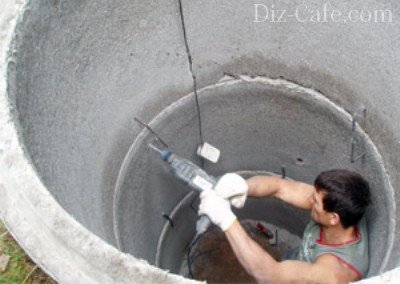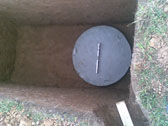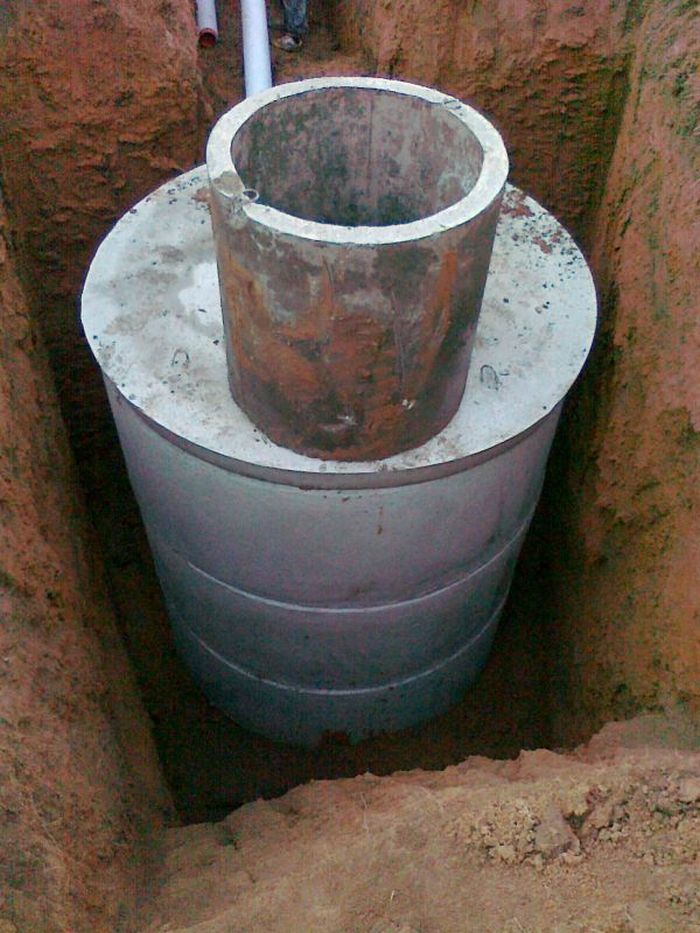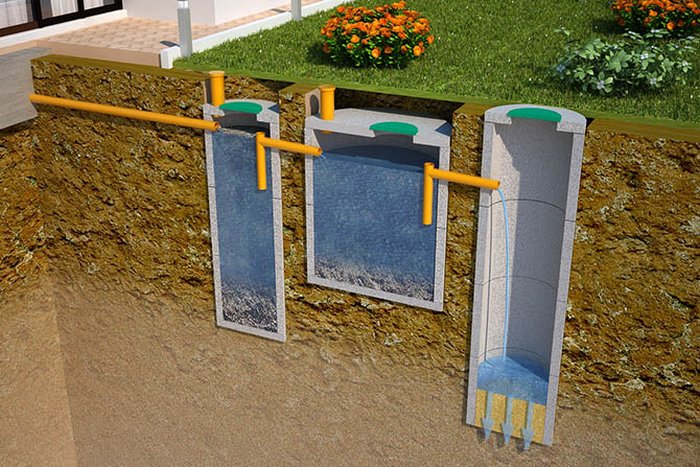
Concrete rings are widely used for constructing wells intended for servicing underground communications. They are widely used due to their ease of assembly and durability of the design. In the private sector, concrete rings are used for the construction of septic tanks or wells. A fairly wide range of these products with standardized diameters is produced. However, in some cases, it makes sense to make them right on the spot, with your own hands. This article provides a calculation calculator concrete rings.
This calculator will help you correctly calculate the required amount of reinforcing mesh and volume concrete mixture based on one product. A cubic meter of concrete made from M400 cement weighs about 2300-2500 kilograms. Having thus determined the approximate mass of one ring, you can make a decision on the lifting mechanism, which will be needed in the future for laying finished products during construction.
To use the calculator, click on the image below:
For self-made rings you will need the following materials and equipment:

The concrete mixture for making rings must be thick enough. The recommended ratio of components (cement - sand - crushed stone - water), in the proportion 1-2-3-0.5, when calculated by volume. If the mixture is poured into the formwork without vibration, then every 20-25 cm it is necessary to tamp the solution using a hand vibrator. After the mold is completely filled and the entire mixture is compacted layer by layer, the upper end is leveled and the finished product is covered with plastic film. The film is necessary to avoid excessive drying.

After 4-5 days, the ring can be freed from the formwork and the next one can be poured. Ready product It is recommended to wrap it with film and let it sit for another 15-20 days so that the concrete finally gains strength, while wetting it with water every 4-5 days. All concrete works it is advisable to perform at steady state average temperature air at least 10⁰С.
The effectiveness of using a septic well on site depends on two parameters - the volume of the well and waterproofing. So, when building wells from reinforced concrete rings , the rings are fastened together cement mortar, and sometimes they are waterproofed on the side adjacent to the soil. The effect of such unfavorable phenomena for concrete as capillary suction can be reduced by using similar waterproofing and high-quality grades of mortar not only at the seams, but also during production well rings.
Let's take a closer look at the use of concrete rings in septic wells.
If we take the component of the need to empty septic wells, then this issue must be approached thoroughly. It is known that the volume of a cylinder is calculated using the following formula
VOLUME = 3.14 * DIAMETER 2 * HEIGHT / 4
That is, we have a nonlinear (quadratic) dependence on the internal radius of the well ring under consideration. For our ring height (900mm concrete ring), we obtain the following results for the volumes of one ring:
0.7m 0.3462 m 3
0.8m 0.4522 m 3
1.0m 0.7065 m 3
1.2m 1.0174 m 3
1.5m 1.5896 m 3
2.0m 2.826 m 3
For example, if you use three rings with a diameter of 0.8 per well for a septic tank, the total volume will be
0.4522x3=1.3565 m 3
With an effective volume of 2/3 we obtain 0.9043 m3. It turns out that you will be faced with the problem of calling a sewer truck “idle”. If we take a septic tank of 5 rings, then total length the required hose for complete mass intake will be 4.5 m + 2 m = 6.5 m, if such a machine cannot be placed close to the well.
The most common use is reinforced concrete rings with a diameter of 1m. Few people know that if such a septic well is not cleaned at least once every 2 years, then solid residues can “seize” and then a jackhammer and crowbar will be required to empty the well. Which, undoubtedly, will not be the most pleasant experience. Even washing with a standard sewer truck may not help (due to the insufficient water pressure achieved by the equipment of such a vehicle)...
 On hot sunny days middle lane In Russia, and in the Moscow region in particular, the soil warms up approximately 0.8 m downward. Therefore, it is desirable that the upper ring is always free (to avoid unwanted evaporation and the effect of “drying out” of the upper layer). Additionally, an important task when building a well from concrete rings is the tightness of closing such a well from above. For this top cover And Luke you have to choose very carefully.
On hot sunny days middle lane In Russia, and in the Moscow region in particular, the soil warms up approximately 0.8 m downward. Therefore, it is desirable that the upper ring is always free (to avoid unwanted evaporation and the effect of “drying out” of the upper layer). Additionally, an important task when building a well from concrete rings is the tightness of closing such a well from above. For this top cover And Luke you have to choose very carefully.
For a quick and professional solution to the above, we suggest using the services of the Three Rings company in a complex!
The use of concrete rings for arranging septic tanks is effective and practical solution for a simple and reliable system. Rings for a reinforced concrete septic tank are easy to use and provide the optimal volume of the prefabricated structure. In addition, concrete rings for septic tanks are affordable, and quick installation will help minimize sewerage costs.
The construction based on concrete rings is different round shape. According to its design, it can be single or multi-chamber. It is advisable to build single-chamber septic tanks in case of volume Wastewater per day no more than 1m3. The number of rings for the sewer structure is no more than 3-5 pieces.
Two-chamber settling tanks are erected with a daily waste volume of up to 10 m3. Three-chamber sedimentation tanks guarantee more thorough cleaning and are installed when daily wastewater volumes exceed 10 m3.
Components of septic tanks:
Important! When starting the installation of concrete rings, it is necessary to check all products for chips, sagging, and cracks, which can be either a manufacturing defect or occur due to improper transportation of elements.
Important! Diameter sizes of round single-chamber settling tanks: 1000 mm, 1500 mm, 2000 mm. The height of the working part is 1.8-2.4 m. The calculation of the number of concrete rings is determined based on the diameter and height of the elements involved in the installation of the sewerage system.

According to standards, water consumption per person is 200 l/day. In order for the sewerage system to work uninterruptedly, the rate of water consumption and the amount of wastewater for 3 days is taken, that is, for a family of 3 people, this is 1.8 m3. Arrangement treatment facilities a larger volume will extend the service life of the sewer system.
Advice! An approximate calculation looks like this: using rings with a diameter of 1 m, a height of 0.8 m and a standard volume of 0.63 m3 (waste volume less than 10 m3), a single-chamber structure of three concrete rings is erected. In the case of constructing a filtration well, it must be remembered that its volume must be at least 12 times higher than the daily water consumption, therefore it is recommended to use wider concrete rings in significant quantities.
Some tips:
Important! The use of rings with seam locks prevents the possibility of horizontal displacement of the structure. The construction of multi-chamber settling tanks should be carried out on a single concrete base, and it is better to assemble the entire system from single-chamber elements, connecting them through pipes.

For the installation of septic tanks, the use of concrete rings, floors, bottoms and hatches with covers is shown High Quality. Manufacturers offer:
Benefits of using rings:
Important! Using concrete rings to install a wastewater treatment system is a practical solution. Due to the large weight, the structures do not need to be anchored, they are less susceptible to deformation during soil movements, and if the sealing has been carried out carefully, then such a tank completely eliminates the ingress of untreated wastewater into the soil.
Moreover, the size of the structure can be any, since it is always possible to expand the structure using additional elements by selecting the correct diameter.
As for varieties and sizes, the elements are in the following order:
| marking | KS10.9 | KS10.85 | KS15.9 | KS20.9 | KS7.9 | PP-10 | PP-10 | PP-15 | PP-15 |
| note | With a lock | With a lock | without lock | without lock | Without hatch | With polymer hatch | Without hatch | With polymer hatch | |
| Inner D (mm) | 1000 | 1500 | 2000 | 700 | Outdoor D1200 | External D 1200 | External D 1700 | External D 1700 | |
| Height (mm) | 900 | 900 | 900 | 900 | 130 | 130 | 140 | 150 | |
| Thickness | 80 | 90 | 90 | 70 | — | — | — | — | |
| Weight, kg) | 550 | 850 | 1350 | 360 | 200 | 240 | 600 | 680 |
Thus, knowing the main characteristics and the volume of the rings, you can calculate costs, take into account the dimensions that a sewer system for a country house or home may have, and also estimate the total amount of work. When using special equipment, the lower structural element It is better to choose one with a bottom to ensure more effective sealing of the entire septic tank.

After the volume and height have been calculated and the dimensions have been taken into account, the sump is assembled and the entire system operates as follows: water enters the purification chambers, where the decay of organic compounds and the clarification of the liquid through beneficial bacteria already occur. The flows are then sent through pipes to a distribution and filtration device. Then the streams, cleared of mud inclusions, seep into the ground or are discharged into natural water intake reservoirs.
Fully finished building of a cleaning nature must be regularly inspected and carried out preventive actions. In particular:
Despite the simplicity and strength of the structures, it is necessary to observe safety measures: ventilate the sump before starting work, take a rope and a lantern into the mine. Depending on the volume of the structure, the frequency of cleaning activities is calculated. In particular, for a dacha equipped with a small number of plumbing fixtures, cleaning can be done no more than 1-2 times a year, and for country house comfortable stay, the procedure is carried out as needed, up to 6-8 times a year.
Important! If it is not possible to determine the volume of water consumption, the calculation takes into account the amount of waste not for 3 days, but for a longer period. In this case, the calculation of the tank capacity increases by 15-20%. In this case, the user can be sure that the sewage system will work flawlessly in both standard and peak modes.